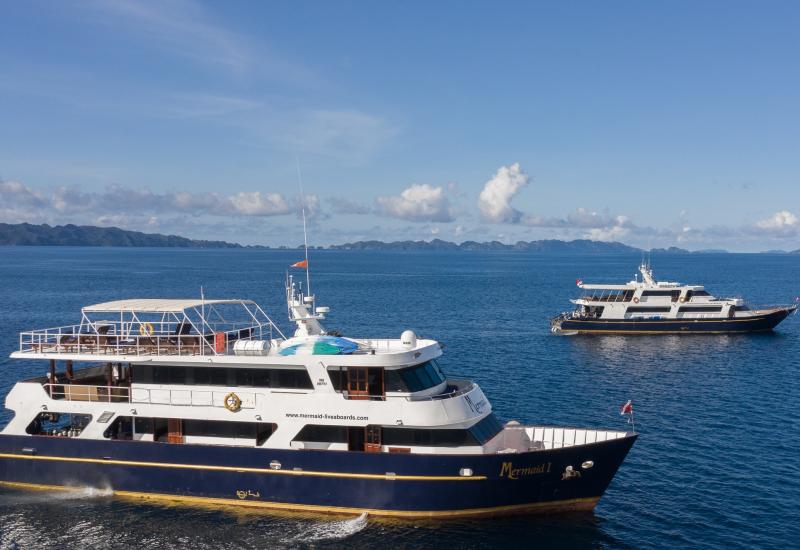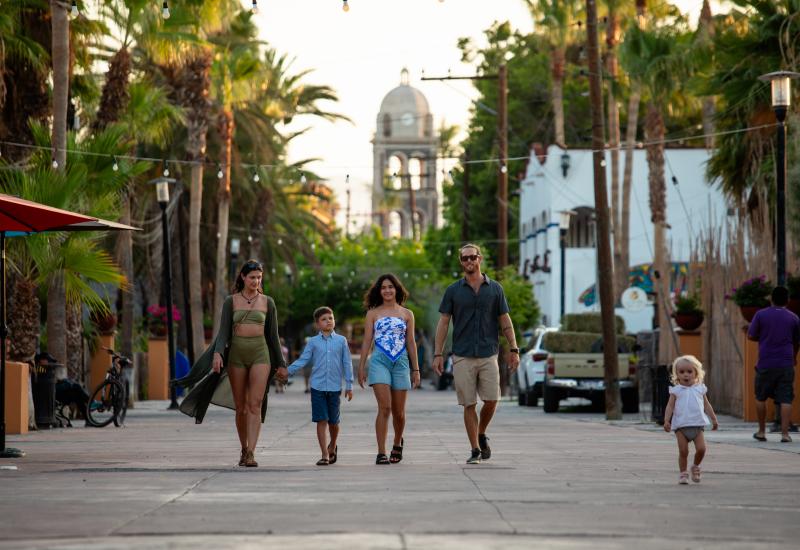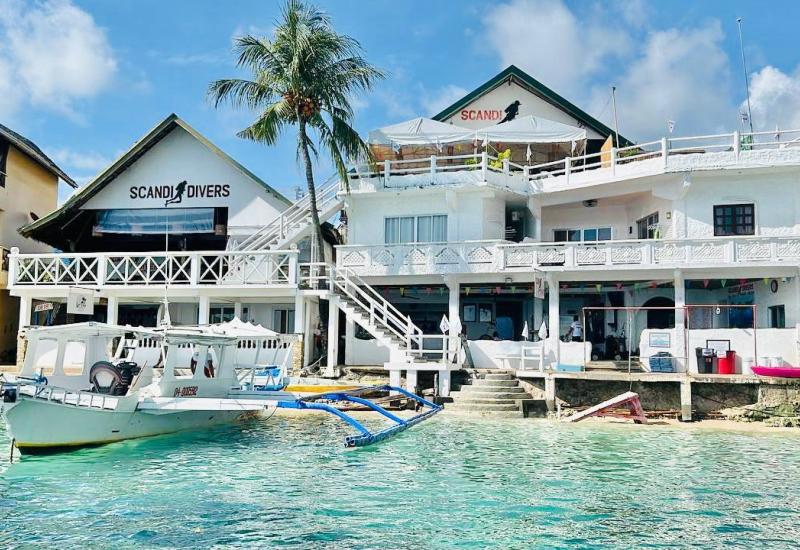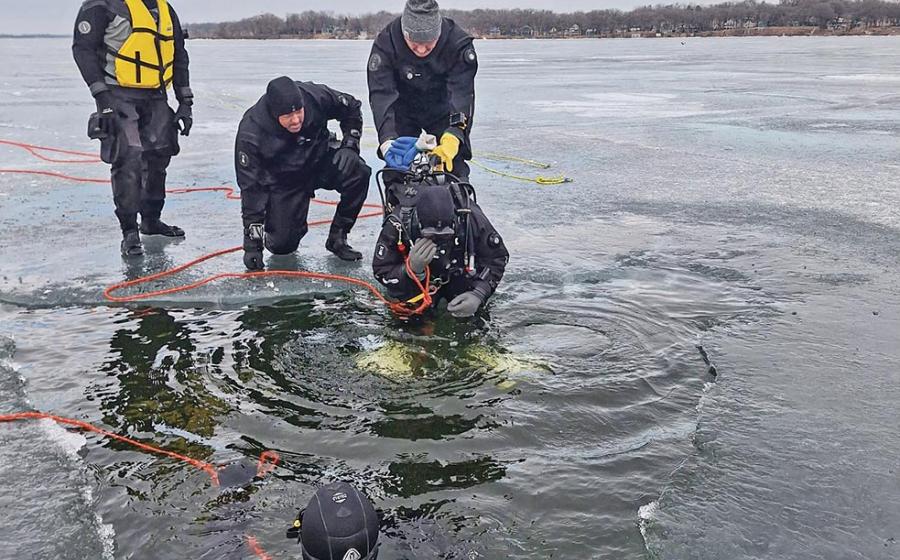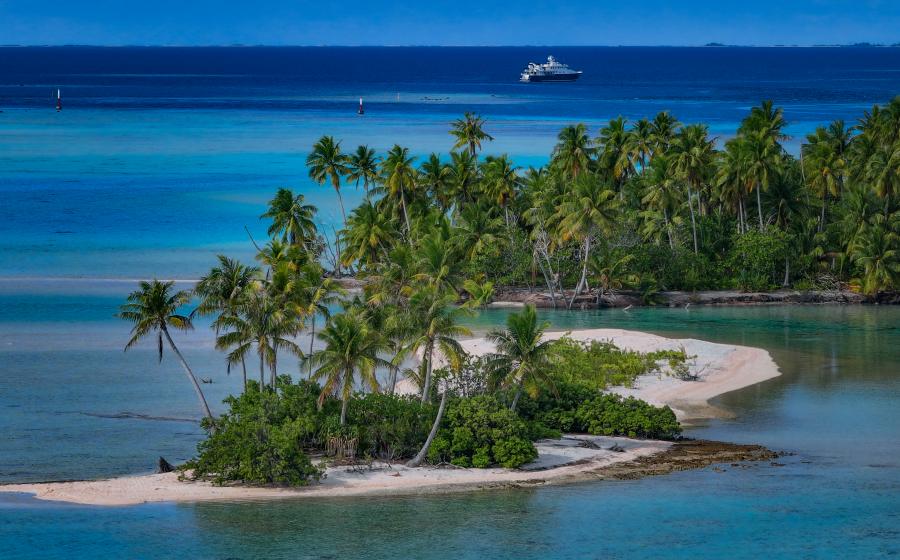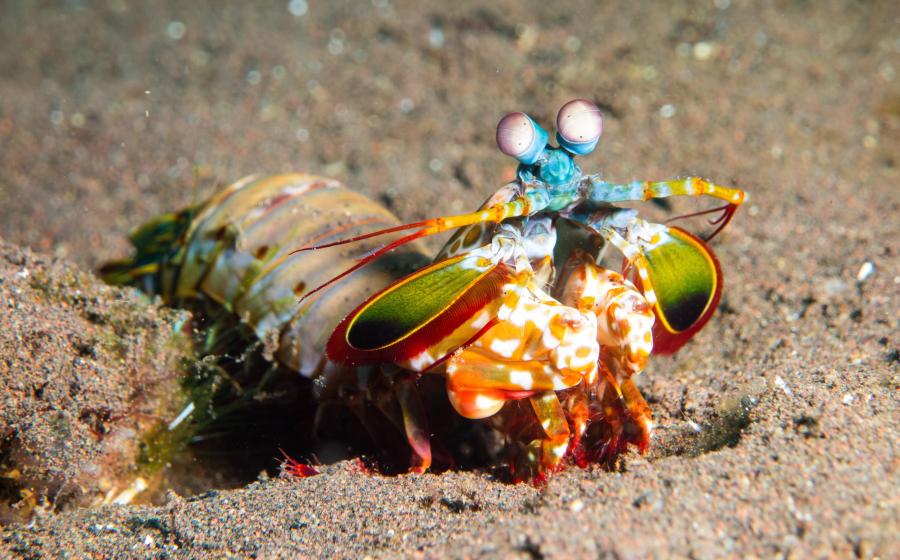Diving Indonesia In Style

By Mark Evans
An increasingly strong current pushes me around the headland, and I struggle to take in the underwater vista opening up before me--huge shoals of surgeonfish swarm in mid-water, pyramid butterflyfish flit above the reef, and spiny lobsters hide among the hard and soft corals and sponges smothering the wall. I could spend hours drifting along the wall, but all too soon, it's time to return to the tender. We surface and are faced with the spectacular sight of an ominous-looking lava flow carving a swath of black down the lush green side of the towering Ruang volcano. Awesome wall dives, myriad species of marine life, stunning topside scenery of the volcanic variety. There is only one place on earth we can be--Indonesia.
I'm in North Sulawesi for the maiden voyage of the brand-new Paradise Dancer, the latest vessel to join the Peter Hughes fleet (see "Luxury Aboard," p. 61). The itinerary is enough to make any diver salivate--the world-renowned Lembeh Strait, Bangka Islands, Bunaken National Marine Park and the Sangihe Islands, all in one 11-day trip.
Lembeh Strait
Indonesia has it all--walls, wrecks, reefs, pelagics, critters. You name it, it's here. North Sulawesi lies smack in the middle of the sprawling archipelago and is one of the most diverse regions of Indonesia. Departing from Bitung Harbor, Paradise Dancer starts its journey in Lembeh Strait, known for its muck diving. It's strange to descend to 50 feet at sites like Hairball and land on a black volcanic sand slopes covered in various pieces of garbage--paint tins, plastic bags, old ropes and discarded fishing nets. The first time you do a muck dive, you wonder why the hell you traveled half the world to dive sites like these. Then you find a cockatoo waspfish, Ambon scorpionfish, mimic octopus or flamboyant cuttlefish, and suddenly the area's attraction is obvious. You have to work at finding these fantastic, bizarre-looking animals, but when you do, it's well worth the effort. And while Lembeh isn't only muck diving--there are a handful of sites like Angel's Window with traditional reefs and even a few wrecks, including the Mawali--the strange creatures in the muck are what draw people back year after year.
Bangka Islands
After two days of looking for tiny stuff, we move to the northeast coast of mainland Sulawesi, and we savor the pristine reefs Indonesia is known for. The islands in this group--Bangka, Talisei (Talise), Kinabohutan, Tindila, Gangga and Tamperong--offer diving on reefs like Batu Mandi, featuring rocky outcrops that form a solid base for soft corals and sponges. The 80-foot-plus visibility lets you get the full effect of this riot of color. The dives here can be prone to strong currents, but when you dive from a tender, you get a live pickup when you surface.
The Bangka Islands' mix of strong currents and pelagics are an irresistible draw for adrenaline-seeking divers. Spotted eagle rays, hawksbill and loggerhead turtles, white-tip and gray reef sharks are common on every dive, but even if they don't show up, you'll find all manner of reef fish, Napoleon wrasse and banded sea snakes. The reefs boast exquisite coral and sponge growth.
Bunaken National Marine Park
The jewel in North Sulawesi's crown, this collection of islands--Bunaken, Siladen, Manado Tua, Montehage and Nain--boasts sheer walls smothered in marine growth, thanks to nutrient-rich water that sweeps up from the depths. Crinoids and basket stars are everywhere, and black triggerfish, anthias and pyramid butterflyfish form dense clouds off the reef edge. Like sites in the Bangka Islands, you can see sharks, rays and barracuda. Conditions at sites like Lekuan I and Siladen are generally benign, and a mild current propels you along the wall.
Siau and Sangihe Islands
After the boat ventures farther north toward Siau and the Sangihe Islands, we explore volcanoes both above and below water. Ruang and Siau islands are dominated by massive volcanoes protruding into the sky, and this topography is reflected underwater, with sheer drop-offs and steep walls. Off Ruang, New Lava Flow, or Basilica, is something else. The blackened lava flow cuts through the lush greenery on the slopes, widening as it nears the water's edge, and plunges into the sea. This desolate landscape seemingly supports no life, but once underwater, I'm blown away by the sheer numbers of fish and the sponge and coral growth.
For something totally different, how about an active underwater volcano? Mahengetang's two cones reach to within a few feet of the surface in a couple of places, and one pinnacle actually breaks through, and then drops off on all sides to below recreational diving depths. Hard corals cloak the steeply sloping walls, while the main volcano has huge boulders and smaller rocks, some of which are so angular, they almost look man-made. Everything has a hint of yellow-orange because of the sulfurous activities below ground, making for an eerie scene.
In the shallows, volcanic activity sends millions of tiny bubbles spiraling to the surface through the rocks and sand patches, and it feels as if I'm swimming through a huge glass of champagne. Put your hand into a sandy patch, and you'll only be able to keep it there for a few seconds because of the intense geothermal heat.
This aerated water must attract marine life, as the area is teeming with fish and other animals. Garfish patrol the shallows, huge shoals of jacks swarm through the pinnacles and sergeant majors jostle for position on the slopes. We also encounter a couple of skittish turtles and a large humphead parrotfish. If you want a dive destination that appeals to all divers, look no further than North Sulawesi, which offers excellent visibility, impressive walls, fantastic coral and sponge growth, and a phenomenal variety of marine life from tiny, bizarre muck-dwellers to big pelagics.
Luxury Aboard Paradise Dancer
The 188-foot, three-masted motor yacht Paradise Dancer may be the ultimate live-aboard. Furnishings are made from teak, ironwood and other quality woods. Stainless steel and chrome detailing gives it a funky modern edge, while original oil paintings make the main salon and every cabin truly unique. Paradise Dancer has a classic hull design, based on American schooners dating from 120 years ago, and is unbelievably spacious. The vessel takes no more than 18 guests in eight large cabins on the lower deck and one master cabin--the 470-square-foot "Master and Commander Suite"--that takes up the entire rear of the main deck level and boasts a suspended king-size bed, separate sitting area with sofa, and jacuzzi.
The dive deck is also good-sized, the sundeck colossal, and the salon and enclosed dining room (there are also two large dining tables in the midships outside) are equally spacious.
Between April and October, Paradise Dancer departs from Bitung Harbor on Sulawesi (the nearest airport is Manado). The 11-day itineraries make it possible to journey north to Siau and the Sangihe Islands and then return south to Bunaken National Marine Park and Lembeh Strait. From November to March, the vessel relocates to the Raja Ampat Islands, departing from Sorong (the nearest airport). Log on to peterhughes.com for more information.
North Sulawesi Dive Site Sampler
Lembeh Strait
Hairball
Depth: 66 feet
Skill level: Beginner
A classic muck dive. The black volcanic sand bottom is home to all manner of bizarre creatures, including mimic octopus, hairy frogfish, dragonets, Ambon scorpionfish, stargazers and cuttlefish. Boats tend to anchor in the shallows, so you'll drop into just 15 feet of water, then make a lazy circuit down to the maximum depth.
Angel's Window
Depth: 110 feet
Skill level: Intermediate
One of the few coral reefs in Lembeh Strait, it's essentially a pinnacle rising from the volcanic sand with a sponge- and coral-encrusted swim-through at 95 feet. At depth it's a traditional muck dive.
Mawali
Depth: 135 feet
Skill level: Advanced
This cargo vessel on its port side offers cavernous holds that can be easily penetrated, but other areas are smothered in silt. Explore the hull and upper sections, which are covered in corals and sponges and play host to nudibranchs, pygmy seahorses, orangutan crabs and mantis shrimp.
Bangka Islands
Batu Mandi
Depth: 60 feet
Skill level: Intermediate
Off the Sulawesi mainland just outside Lembeh Strait, this site isn't visted often, but if you're lucky enough to dive here, you'll be rewarded with a sloping reef adorned with pristine hard and soft corals, and sponges. Frogfish, spiny lobster, moray eels and giant pufferfish are common sights.
Bunaken National Marine Park
Tanjung Kopi
Depth: 140 feet-plus
Skill level: Advanced
Off the northwest coastline of Bunaken, Manado Tua volcano is a sheer wall that falls rapidly below recreational limits. Strong currents sweep along it and around the point, bringing in white-tip reef sharks, eagle rays and turtles.
Lekuan I
Depth: 140 feet-plus
Skill level: Intermediate
Even though this is a fairly steep drop-off into the abyss, there is generally little to no current, making it a good option for newcomers to wall diving. Plenty of good coral growth and marine life, including Napoleon wrasse, bumphead parrotfish, lionfish and swarms of anthias.
Siladen
Depth: 125 feet
Skill level: Advanced
This sheer wall--which shares its name with Siladen Island, just northeast of Bunaken Island--drops to around 125 feet before sloping off gradually into the deep. The sometimes strong current running here brings in tuna, jacks and barracuda.
Siau & Sangihe Islands
Mahengetang Underwater Volcano
Depth: 140 feet-plus
Skill level: Advanced
As soon as you jump in the water at this site between Siau and Sangihe islands, you realize that you are diving on top of a volcano. Strong currents attract horse-eye jacks, but it's also possible to find sheltered areas.
Lehe Wall
Depth: 140 feet-plus
Skill level: Advanced
Off Siau, this sheer wall is constantly washed by currents, which bring in shoals of horse-eye jacks, and the occasional barracuda, eagle ray and hawksbill turtle. Soft coral growth is prolific along the top section of the wall.
New Lava Flow (Basilica)
Depth: 140 feet-plus
Skill level: Advanced
Off Ruang Island, south of Siau, the wall here is swept by strong currents that bring in large schools of fish and nourish the large barrel and vase sponges protruding from its face.
InDepth
Dive Conditions: There are two seasons in Indonesia: the dry season, which extends from May to November, and the rainy season, which lasts from December to April. Live-aboard sailing here takes place from April to September. Water temps are in the low 80s during the dry season. Vis averages 80 feet.
Weather: Mid-70s during the dry season; low 80s during the rainy season.
Money Matters: Currency is the rupiah (IDR). Departure tax is IDR100,000.
Getting There: The most direct way to reach the Manado airport (MDC) on Sulawesi is via Singapore (SIN). Singapore to Manado is on Silk Air, Singapore Air's regional carrier, with five direct flights weekly. Flight time from Singapore to Manado is three hours, 20 minutes. There are no nonstop flights from the U.S. Flights from Los Angeles to Singapore normally take about 18 hours. Depending on flight schedules, you might have to overnight in Manado prior to boarding Paradise Dancer in Bitung Harbor. If you enter Indonesia in Bali (DPS) or Jakarta (JKT), there are daily departures to Manado.
Get More: peterhughes.com/destination/northsulawesi or scubadiving.com/travel/pacificandindianoceans/indonesia.

By Mark Evans
An increasingly strong current pushes me around the headland, and I struggle to take in the underwater vista opening up before me--huge shoals of surgeonfish swarm in mid-water, pyramid butterflyfish flit above the reef, and spiny lobsters hide among the hard and soft corals and sponges smothering the wall. I could spend hours drifting along the wall, but all too soon, it's time to return to the tender. We surface and are faced with the spectacular sight of an ominous-looking lava flow carving a swath of black down the lush green side of the towering Ruang volcano. Awesome wall dives, myriad species of marine life, stunning topside scenery of the volcanic variety. There is only one place on earth we can be--Indonesia.
I'm in North Sulawesi for the maiden voyage of the brand-new Paradise Dancer, the latest vessel to join the Peter Hughes fleet (see "Luxury Aboard," p. 61). The itinerary is enough to make any diver salivate--the world-renowned Lembeh Strait, Bangka Islands, Bunaken National Marine Park and the Sangihe Islands, all in one 11-day trip.

Lembeh Strait
Indonesia has it all--walls, wrecks, reefs, pelagics, critters. You name it, it's here. North Sulawesi lies smack in the middle of the sprawling archipelago and is one of the most diverse regions of Indonesia. Departing from Bitung Harbor, Paradise Dancer starts its journey in Lembeh Strait, known for its muck diving. It's strange to descend to 50 feet at sites like Hairball and land on a black volcanic sand slopes covered in various pieces of garbage--paint tins, plastic bags, old ropes and discarded fishing nets. The first time you do a muck dive, you wonder why the hell you traveled half the world to dive sites like these. Then you find a cockatoo waspfish, Ambon scorpionfish, mimic octopus or flamboyant cuttlefish, and suddenly the area's attraction is obvious. You have to work at finding these fantastic, bizarre-looking animals, but when you do, it's well worth the effort. And while Lembeh isn't only muck diving--there are a handful of sites like Angel's Window with traditional reefs and even a few wrecks, including the Mawali--the strange creatures in the muck are what draw people back year after year.
Bangka Islands
After two days of looking for tiny stuff, we move to the northeast coast of mainland Sulawesi, and we savor the pristine reefs Indonesia is known for. The islands in this group--Bangka, Talisei (Talise), Kinabohutan, Tindila, Gangga and Tamperong--offer diving on reefs like Batu Mandi, featuring rocky outcrops that form a solid base for soft corals and sponges. The 80-foot-plus visibility lets you get the full effect of this riot of color. The dives here can be prone to strong currents, but when you dive from a tender, you get a live pickup when you surface.
The Bangka Islands' mix of strong currents and pelagics are an irresistible draw for adrenaline-seeking divers. Spotted eagle rays, hawksbill and loggerhead turtles, white-tip and gray reef sharks are common on every dive, but even if they don't show up, you'll find all manner of reef fish, Napoleon wrasse and banded sea snakes. The reefs boast exquisite coral and sponge growth.
Bunaken National Marine Park
The jewel in North Sulawesi's crown, this collection of islands--Bunaken, Siladen, Manado Tua, Montehage and Nain--boasts sheer walls smothered in marine growth, thanks to nutrient-rich water that sweeps up from the depths. Crinoids and basket stars are everywhere, and black triggerfish, anthias and pyramid butterflyfish form dense clouds off the reef edge. Like sites in the Bangka Islands, you can see sharks, rays and barracuda. Conditions at sites like Lekuan I and Siladen are generally benign, and a mild current propels you along the wall.
Siau and Sangihe Islands
After the boat ventures farther north toward Siau and the Sangihe Islands, we explore volcanoes both above and below water. Ruang and Siau islands are dominated by massive volcanoes protruding into the sky, and this topography is reflected underwater, with sheer drop-offs and steep walls. Off Ruang, New Lava Flow, or Basilica, is something else. The blackened lava flow cuts through the lush greenery on the slopes, widening as it nears the water's edge, and plunges into the sea. This desolate landscape seemingly supports no life, but once underwater, I'm blown away by the sheer numbers of fish and the sponge and coral growth.

For something totally different, how about an active underwater volcano? Mahengetang's two cones reach to within a few feet of the surface in a couple of places, and one pinnacle actually breaks through, and then drops off on all sides to below recreational diving depths. Hard corals cloak the steeply sloping walls, while the main volcano has huge boulders and smaller rocks, some of which are so angular, they almost look man-made. Everything has a hint of yellow-orange because of the sulfurous activities below ground, making for an eerie scene.
In the shallows, volcanic activity sends millions of tiny bubbles spiraling to the surface through the rocks and sand patches, and it feels as if I'm swimming through a huge glass of champagne. Put your hand into a sandy patch, and you'll only be able to keep it there for a few seconds because of the intense geothermal heat.
This aerated water must attract marine life, as the area is teeming with fish and other animals. Garfish patrol the shallows, huge shoals of jacks swarm through the pinnacles and sergeant majors jostle for position on the slopes. We also encounter a couple of skittish turtles and a large humphead parrotfish. If you want a dive destination that appeals to all divers, look no further than North Sulawesi, which offers excellent visibility, impressive walls, fantastic coral and sponge growth, and a phenomenal variety of marine life from tiny, bizarre muck-dwellers to big pelagics.
Luxury Aboard Paradise Dancer
The 188-foot, three-masted motor yacht Paradise Dancer may be the ultimate live-aboard. Furnishings are made from teak, ironwood and other quality woods. Stainless steel and chrome detailing gives it a funky modern edge, while original oil paintings make the main salon and every cabin truly unique. Paradise Dancer has a classic hull design, based on American schooners dating from 120 years ago, and is unbelievably spacious. The vessel takes no more than 18 guests in eight large cabins on the lower deck and one master cabin--the 470-square-foot "Master and Commander Suite"--that takes up the entire rear of the main deck level and boasts a suspended king-size bed, separate sitting area with sofa, and jacuzzi.
The dive deck is also good-sized, the sundeck colossal, and the salon and enclosed dining room (there are also two large dining tables in the midships outside) are equally spacious.
Between April and October, Paradise Dancer departs from Bitung Harbor on Sulawesi (the nearest airport is Manado). The 11-day itineraries make it possible to journey north to Siau and the Sangihe Islands and then return south to Bunaken National Marine Park and Lembeh Strait. From November to March, the vessel relocates to the Raja Ampat Islands, departing from Sorong (the nearest airport). Log on to peterhughes.com for more information.

North Sulawesi Dive Site Sampler
Lembeh Strait
Hairball
Depth: 66 feet
Skill level: Beginner
A classic muck dive. The black volcanic sand bottom is home to all manner of bizarre creatures, including mimic octopus, hairy frogfish, dragonets, Ambon scorpionfish, stargazers and cuttlefish. Boats tend to anchor in the shallows, so you'll drop into just 15 feet of water, then make a lazy circuit down to the maximum depth.
Angel's Window
Depth: 110 feet
Skill level: Intermediate
One of the few coral reefs in Lembeh Strait, it's essentially a pinnacle rising from the volcanic sand with a sponge- and coral-encrusted swim-through at 95 feet. At depth it's a traditional muck dive.
Mawali
Depth: 135 feet
Skill level: Advanced
This cargo vessel on its port side offers cavernous holds that can be easily penetrated, but other areas are smothered in silt. Explore the hull and upper sections, which are covered in corals and sponges and play host to nudibranchs, pygmy seahorses, orangutan crabs and mantis shrimp.
Bangka Islands
Batu Mandi
Depth: 60 feet
Skill level: Intermediate
Off the Sulawesi mainland just outside Lembeh Strait, this site isn't visted often, but if you're lucky enough to dive here, you'll be rewarded with a sloping reef adorned with pristine hard and soft corals, and sponges. Frogfish, spiny lobster, moray eels and giant pufferfish are common sights.
Bunaken National Marine Park
Tanjung Kopi
Depth: 140 feet-plus
Skill level: Advanced
Off the northwest coastline of Bunaken, Manado Tua volcano is a sheer wall that falls rapidly below recreational limits. Strong currents sweep along it and around the point, bringing in white-tip reef sharks, eagle rays and turtles.
Lekuan I
Depth: 140 feet-plus
Skill level: Intermediate
Even though this is a fairly steep drop-off into the abyss, there is generally little to no current, making it a good option for newcomers to wall diving. Plenty of good coral growth and marine life, including Napoleon wrasse, bumphead parrotfish, lionfish and swarms of anthias.
Siladen
Depth: 125 feet
Skill level: Advanced
This sheer wall--which shares its name with Siladen Island, just northeast of Bunaken Island--drops to around 125 feet before sloping off gradually into the deep. The sometimes strong current running here brings in tuna, jacks and barracuda.
Siau & Sangihe Islands
Mahengetang Underwater Volcano
Depth: 140 feet-plus
Skill level: Advanced
As soon as you jump in the water at this site between Siau and Sangihe islands, you realize that you are diving on top of a volcano. Strong currents attract horse-eye jacks, but it's also possible to find sheltered areas.
Lehe Wall
Depth: 140 feet-plus
Skill level: Advanced
Off Siau, this sheer wall is constantly washed by currents, which bring in shoals of horse-eye jacks, and the occasional barracuda, eagle ray and hawksbill turtle. Soft coral growth is prolific along the top section of the wall.
New Lava Flow (Basilica)
Depth: 140 feet-plus
Skill level: Advanced
Off Ruang Island, south of Siau, the wall here is swept by strong currents that bring in large schools of fish and nourish the large barrel and vase sponges protruding from its face.

InDepth
Dive Conditions: There are two seasons in Indonesia: the dry season, which extends from May to November, and the rainy season, which lasts from December to April. Live-aboard sailing here takes place from April to September. Water temps are in the low 80s during the dry season. Vis averages 80 feet.
Weather: Mid-70s during the dry season; low 80s during the rainy season.
Money Matters: Currency is the rupiah (IDR). Departure tax is IDR100,000.
Getting There: The most direct way to reach the Manado airport (MDC) on Sulawesi is via Singapore (SIN). Singapore to Manado is on Silk Air, Singapore Air's regional carrier, with five direct flights weekly. Flight time from Singapore to Manado is three hours, 20 minutes. There are no nonstop flights from the U.S. Flights from Los Angeles to Singapore normally take about 18 hours. Depending on flight schedules, you might have to overnight in Manado prior to boarding Paradise Dancer in Bitung Harbor. If you enter Indonesia in Bali (DPS) or Jakarta (JKT), there are daily departures to Manado.
Get More: peterhughes.com/destination/northsulawesi or scubadiving.com/travel/pacificandindianoceans/indonesia.

